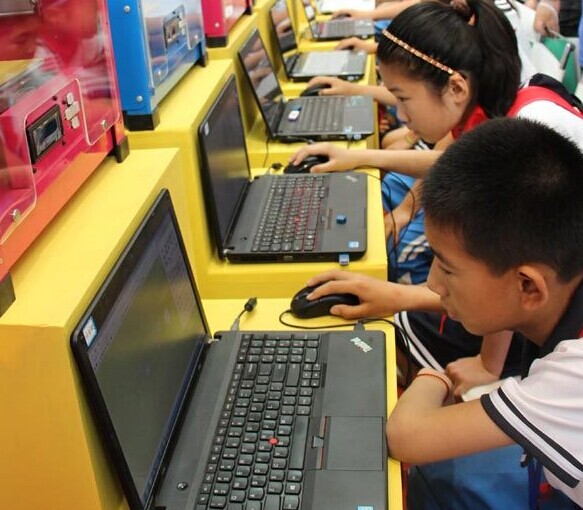

Children experience 3-D printing technology at the booth of Qingdao Unique Products Develop Co Ltd, a local maker of 3-D printers, at the 2014 World 3-D Printing Technology Industry Conference & Exhibition. Provided to China Daily
China on track to become world's biggest market in three years, say industry sources
China is on track to become the world's biggest 3-D printing market by turnover - in the best-case scenario - three years from now, industry sources said on Thursday.
However, to achieve this it needs to quickly embrace additive manufacturing technology, better known as 3-D printing, to add flexibility and boost innovation.
"China's appetite for 3-D printing technology has been surging immensely since last year. Increasing demand has given the nation momentum to become the world's No 1 in the next three to five years," said Graham Tromans, president of the United Kingdom-based 3-D printing consultancy G. P. Tromans Associates.
The United States is the current No 1 market for 3-D printing.
Although technology storage for Chinese 3-D printer manufacturers is "slightly behind" that of the leading brands in the US, local players are working hard to catch up with the international standard, Tromans said.
Chinese vendors are already making significant strides in the global arena with "the biggest" or "world's first" 3-D printing projects.
Qingdao Unique Products Develop Co Ltd, a local maker of 3-D printers, unveiled the world's largest printer on Thursday. The machine's first task is to print a 12 meter-high Temple of Heaven model using fiber reinforced plastic.
Once built, it will be the world's biggest structure constructed by additive manufacturing technology.
Company founder Wang Hong said research abilities are its core competitiveness, and indicated that it would also expand into other sectors like the medical, design and creative culture markets in the future.
Turnover for China's 3-D printing market is most likely to reach 4 billion yuan ($642 million) by the end of this year, double that of last year, said sources from industry organization China 3-D Printing Technology Industry Alliance.
Low-end desktop printers are still the major revenue contributors. "The country has added about 50 3-D printer manufacturers over the past year and most of them provide low-precision devices," said Luo Jun, chief executive of the alliance.
Rapid growth in the low-end printer market may cause intense competition next year, Luo said.
"The absence of a proper profit model is the major obstacle hindering the 3-D printing industry right now, and it takes a long time to educate traditional manufacturers about 3-D techniques," he said.
Markets that require high customization involvement are the most suitable areas for 3-D printing technology, said Jack Keverian, professor emeritus of Philadelphia-based Drexel University.
"The technology was not designed for mass production since its birth more than 20 years ago. Chinese firms should be aware that 3-D printing is not the best solution to make business card cases," Keverian said.
Keverian also advised continuous investment in the sector, warning off investors seeking quick returns.
"Patience and long life are critical success ingredients for printer vendors in China," said the 85-year-old industry veteran.
Support from the government will help top-tier players gain an advantage while competing on the global stage, said experts.
Officials from the Ministry of Industry and Information Technology pledged to announce a "long-term route map" for 3-D printing market as early as 2012.
Market of 3D printers to double in 2014
2014-06-19Double-digit growth in 3D printer income
2014-06-053D-printed houses built in Shanghai
2014-04-14World 3D printing technology expo opens in Qingdao
2014-06-193-D printers create new hype in fashion
2014-05-263-D printing adds new dimension to startups
2014-04-243-D printing adds wings to aviation
2013-08-13Copyright ©1999-2018
Chinanews.com. All rights reserved.
Reproduction in whole or in part without permission is prohibited.